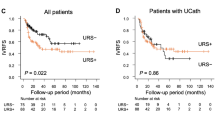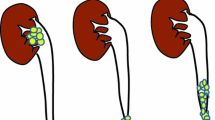Abstract
Purpose
To compare frequency of new and recurrent urothelial cell carcinoma (UCC) among patients with and without pseudodiverticulosis on imaging.
Methods
This retrospective case–control study compared all 113 sequential patients with ureteral pseudodiverticulosis on radiographic urography between 1/1/2002 and 12/31/2012. Six patients were lost to follow-up. 107 patients without pseudodiverticulosis were matched by imaging modality, clinical indication, and tumor grade. Known UCC and primary outcome of new or recurrent UCC were determined through pathology on cystoscopy or clinical follow-up.
Results
Nearly half of patients with pseudodiverticulosis had known UCC at the time of imaging (49/107, 46%). Mean cystoscopy follow-up was 7.0 and 4.6 years for pseudodiverticulosis cases with and without known UCC, respectively, and 7.5 and 7.3 years for controls, respectively. Mean clinic follow-up was 7.5 and 6.0 years for pseudodiverticulosis cases with and without known UCC, respectively, and 6.4 and 7.6 years for controls, respectively. Among patients with known UCC at the time of imaging, similar rates of recurrent UCC were demonstrated on follow-up among patients with pseudodiverticulosis (6/49, 12%) and without (7/49, 14%). Among patients with no known history of UCC at the time of imaging, no patients with pseudodiverticulosis developed UCC on follow-up and 5% (3/58) of patients without pseudodiverticulosis developed UCC.
Conclusion
Although half of patients with ureteral pseudodiverticulosis have a known diagnosis of UCC, the presence of pseudodiverticulosis did not signify an increased likelihood of developing new or recurrent UCC over the follow-up period.


Similar content being viewed by others
References
Wasserman NF, Posalaky IP, Dykoski R (1988) The pathology of ureteral pseudodiverticulosis. Investig Radiol 23(8):592–598
Spalluto LB, Woodfield CA (2009) Ureteral pseudodiverticulosis: a unique case diagnosed by multidetector computed tomography. J Comput Assist Tomogr 33(2):286–287
Kawashima A, Vrtiska TJ, LeRoy AJ, et al. (2004) CT urography. Radiographics 24(Suppl 1):S35–S54 ((discussion S55–S58))
Vrtiska TJ, Hartman RP, Kofler JM, et al. (2009) Spatial resolution and radiation dose of a 64-MDCT scanner compared with published CT urography protocols. Am J Roentgenol 192(4):941–948
Krishnan V, Chawla A, Sharbidre KG, Peh WCG (2018) Current techniques and clinical applications of computed tomography urography. Curr Probl Diagn Radiol 47(4):245–256
Wasserman NF, Zhang G, Posalaky IP, Reddy PK (1991) Ureteral pseudodiverticula: frequent association with uroepithelial malignancy. Am J Roentgenol 157(1):69–72
Wasserman NF, La Pointe S, Posalaky IP (1985) Ureteral pseudodiverticulosis. Radiology 155(3):561–566
Chang SS, Boorjian SA, Chou R, et al. (2016) Diagnosis and treatment of non-muscle invasive bladder cancer: AUA/SUO guideline. J Urol 196(4):1021–1029
Kenney PJ, Wasserman NF (1987) Ureteral pseudodiverticulosis associated with carcinoma of renal pelvis. Urol Radiol 9(3):161–163
Author information
Authors and Affiliations
Corresponding author
Ethics declarations
Funding
No funding for this study.
Conflict of interest
No conflict of interest.
Ethical approval
All procedures performed in studies involving human participants were in accordance with the ethical standards of the institutional and/or national research committee and with the 1964 Helsinki declaration and its later amendments or comparable ethical standards.
Informed consent
A waiver for informed consent was granted by the institutional IRB
Rights and permissions
About this article
Cite this article
Morgan, M.A., Chua, W.Y., Zafar, H.M. et al. Ureteral pseudodiverticulosis and urothelial cell carcinoma: rethinking the association. Abdom Radiol 44, 234–238 (2019). https://doi.org/10.1007/s00261-018-1726-6
Published:
Issue Date:
DOI: https://doi.org/10.1007/s00261-018-1726-6




